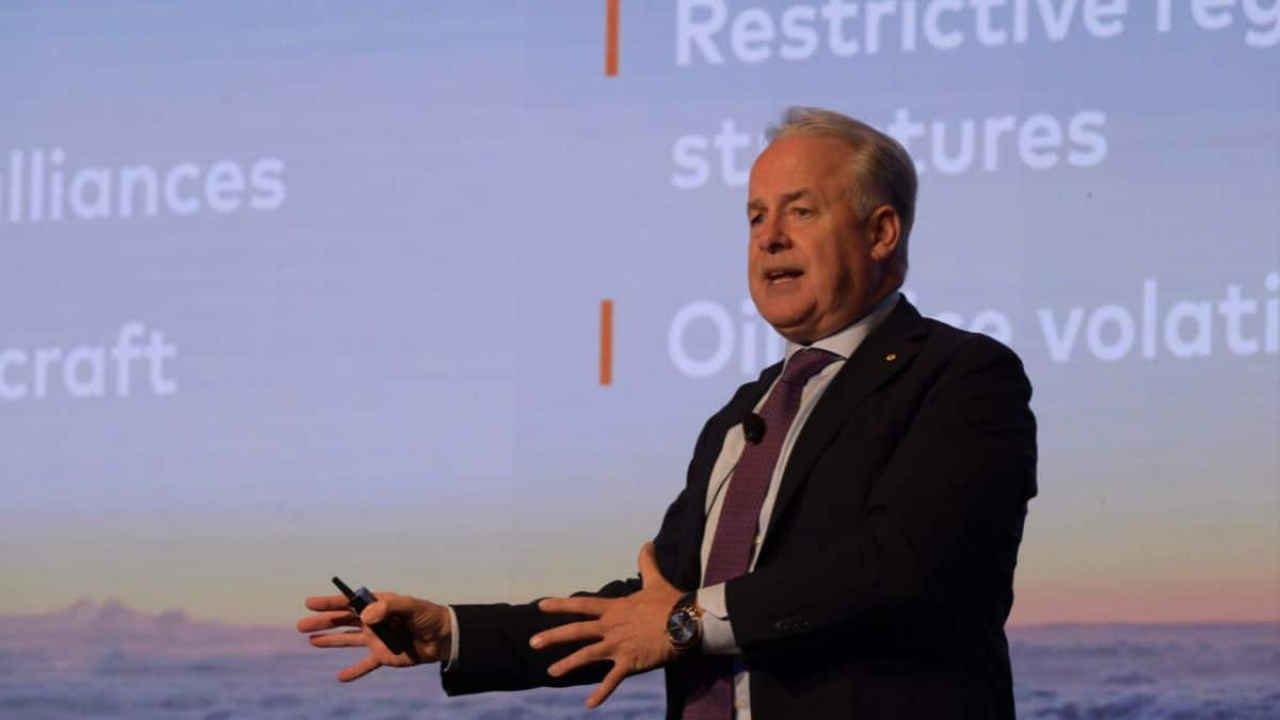Stand out seats
Seating was one of the key focuses when Aircraft Interiors Middle East took place in Dubai in January.

The aircraft cabin interiors market is projected to continue growing dramatically.
According to figures produced by Aircraft Interiors Middle East (AIME) organiser, Tarsus F&E LLC Middle East, it will leap from $16.87 billion in 2016 to $29.16 billion by 2021.
AIME, together with the co-located MRO event, received 4,541 trade visitors. It featured 320 exhibitors and many have already booked to return next year.
“The commitment we have seen from exhibitors is testament to the value they achieve from exhibiting at these events and demonstrates their importance to the industry,” said aerospace director Caryn McConnachie.
AIME had a variety of exhibitors but it was clear that aircraft seating companies played a key role.
Aviointeriors introduced its new Galileo full-flat business-class seat. The staggered 21-inch pitch seat allows all passengers free access to the aisle and provides several stowage points.
Its creation came about in double-quick time. “We were originally working on our Adagio seat when we were visited by a customer from south east Asia looking for a completely new seat for an A330 – he wanted a comfortable seat built from zero,” explained Gianluigi Mormile, senior sales manager.
“We slowed down work on the Adagio to concentrate on this new seat as quickly as we could. From the day the customer came in, we managed to design, produce and get the Galileo certified within six months.”
The seat can also be certified for 787 and 747 or A350 aircraft.
The company soon got back to working on its Adagio, which was presented at this year’s AIX in Hamburg.
“The Adagio is a new high-density business-class seat for both wide and narrow-body aircraft, ranging from eight abreast to five,” explained Mormile. “The seat is aligned as all-forward facing with exclusive 100% aisle access and 100% fully flat configuration.”
Mormile explained why he believes Aviointeriors stands out: “We have more than 40 years’ experience in design and certification. We are very flexible when it comes to customisation too, which can’t be said for many of our competitors.”
Acro Aircraft Seating was attending the show for the second time hoping to generate interest in the Middle East.
“It’s important for us to attend AIME and demonstrate why our seats are so good and why they can work for this region,” said Alan McInnes, SVP sales.
The 11-year-old company currently has a 100,000 seats flying – mainly with European and US carriers.
“The whole fundamental behind the Acro design is that we remove more sources of discomfort by giving more space to the passenger. An Acro seat offers two inches more legroom because of the unique design of the seat,” explained McInnes.
The company has a series of seats that incorporate extra spatial design.
“A lot of seats are just straight at the body with a fist size space that is lost; we have a curve,” said McInnes.
“Extraspatial design maximises the 'micro spaces' that are often overlooked in traditional aircraft seating. By looking at the ‘space within the space’ our approach optimises hidden dimensions in a way that creates extraordinary differences to passenger experience.
“If you were designing a seat from an engineering perspective, you would make every seat the same. However, with an Acro seat, you will see one with 18.5 inches and the middle one with 19-and-a-quarter inches – we can do this in an Airbus cabin.
“With a Boeing aircraft, it typically has a 17-inch seat but we have made one almost 18 inches. Our theory is that it is important to give the space to the passenger.”
UK company Pitch chose AIME to launch its two new dress covers for its PF3000 fixed recline seat.
“The first cover is from our lightweight baseline range and is presented in Lantal fabric with a printed leather antimacassar from Andrew Muirhead. The second is from our comfort range and is presented in e-leather with a contrasting stitch,” said Gary Doy, director.
The PF3000 seat was developed in-house and builds on the attributes of the company’s PF2000 product.
“The seat back is sculptured with a low-profile bungee storage system and an optimised table shape, providing excellent leg room, even at the tightest pitch,” said Doy. “The patented lightweight cushion system delivers a comfortable seat, which is easy to keep clean and maintain during service.”
The company developed an efficient and flexible assembly process by adopting lean manufacturing techniques.
“Manufacturing lead times can be minimised as high-value components and sub-assemblies are bought in from a proven UK-based supply chain,” said Doy. “We currently work on a 12-week lead time for delivery of the standard fixed-back product. However, for customers who require shorter lead times, the company holds sufficient stock to deliver an initial ship set or two. The assembly facility is highly scalable and has the capacity to deliver more than 1000 PAX places a week.”
First deliveries are for the A319, A320, B737-300 and B737-500 aircraft.
A new aerospace foam technology was being displayed by Slovenian company, Vanema, which creates seat and back rest cushions.
“Octaspring is a key enabling technology that will reinvent passenger comfort, while at the same time shaving off up to 30% of the seat cushion’s weight,” explained Boris Ribicic, director of research and development.
“The patented foam springs are used to create individual support points, unlike the rigid uniform blocks of foam that fly on today’s aircraft, and they can be manufactured in varying firmness – which are colour coded – allowing for the creation of unique ergonomic zones without additional costs.”
In 2016, the company teamed up with Airbus, Stelia Aerospace, and Boxmark to develop aircraft seats with Octaspring – with a prototype seat winning a Crystal Cabin Award for excellence in aircraft innovation at the Farnborough International Air Show last year.
Ribicic said Stelia Aerospace is now at the stage where it is ready to market the product after it passed all necessary tests.
While displaying a range of its seating dress covers at the show, Sabeti Wain
was also highlighting its recent large expansion at its facilities at Dubai Airport Freezone (DAFZA). It had grown the factory after struggling to hire skilled staff at its UK and US facilities.
“In the last four or five years, we have had to move a lot of our work from the UK, our main plant, and the US to our facility at DAFZA as we are able to get the right size premises and skilled staff there,” said director, Paymen Sabeti.
“We have gone from 2,500sqm to 5,000sqm at DAFZA and have increased from 150 sewing machinists to 300 – all of which are extremely skilled Pakistani guys. This recent expansion now makes Dubai our largest facility.”
Sabeti said that the company is finding a shift in the nature of the business in the region.
“The Middle East is changing,” he said. “The airlines in this region are trying to save costs. They now refurbish and reuse equipment rather than having new OEM parts. So, on the one hand you see the new part business is going down but the refurbishment and the spares business are going up.”
He added that there is “a lot of pressure and emphasis” on cost-cutting and getting more lifespan out of products.
“For us, we are designing more time-saving equipment seat covers and trying to expand the life cycle of the products,” said Sabeti. “Where a seat cover would have a life span of 10 dry clean cycles in the past, we are extending that to 15 or 20 – double what it used to be. We are being driven by our customers.”
Stay up to date
Subscribe to the free Times Aerospace newsletter and receive the latest content every week. We'll never share your email address.

